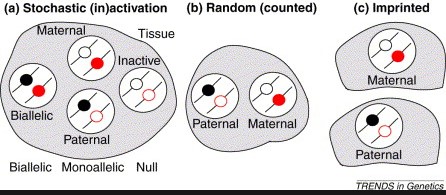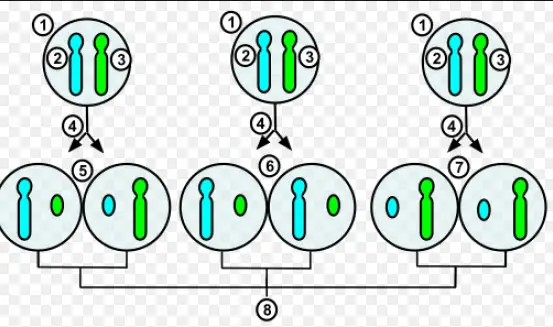Genetic regulation mechanisms are pivotal in the vast landscape of biology, serving as the architects of our genetic blueprint. They dictate not only our inherited traits but also how our genes respond to the environment. Among these mechanisms, X inactivation and genomic imprinting stand out for their unique roles in gene expression. Both processes ensure the proper development and function of organisms but operate through distinct pathways and principles.
X inactivation and genomic imprinting are both mechanisms that control gene expression in a parent-of-origin specific manner. X inactivation is a process that occurs in female mammals where one of the two X chromosomes is randomly inactivated in each cell, ensuring that females, like males, have one functional copy of the X chromosome. On the other hand, genomic imprinting involves the silencing of certain genes depending on whether they are inherited from the mother or the father, affecting only a small subset of genes.
These regulatory mechanisms are not just academic curiosities; they have profound implications for our understanding of genetics, development, and diseases. X inactivation is crucial for balancing gene dosage between males and females, while genomic imprinting can influence traits and conditions that are passed from parents to offspring. The differences between these processes underscore the complexity of genetic regulation and its impact on health and disease.

Genetic Basics
Chromosomes and DNA
Chromosomes are long, thread-like structures made of DNA and protein. They carry our genetic information. Humans have 23 pairs of chromosomes, including one pair of sex chromosomes, making a total of 46. The role of DNA in genetics is foundational. It contains the instructions needed for an organism to develop, survive, and reproduce. DNA sequences are called genes.
Gene Expression
Gene expression is how information from a gene is used to build functional products like proteins. This process is vital for the cell’s function, growth, and adaptation. Mechanisms controlling gene expression include transcription (copying DNA to RNA) and translation (building proteins from RNA). Other factors, like epigenetic modifications, can also influence gene expression without changing the DNA sequence.
X Inactivation
What Is X Inactivation?
X inactivation is a process that silences one of the two X chromosomes in female mammals. This equalizes the expression of X-chromosomal genes between males (XY) and females (XX). The concept was first discovered by Mary Lyon in 1961, marking a significant advancement in genetic research.
Process of X Inactivation
- Initiation: One X chromosome is chosen to be inactivated randomly in each cell.
- Spreading: The inactivation spreads across the X chromosome.
- Maintenance: The inactive state of the X chromosome is maintained through cell divisions.
Barr bodies are the visible representation of inactivated X chromosomes in the nucleus, significant for genetic and forensic analyses.
Biological Significance
X inactivation prevents overexpression of X-linked genes in females, maintaining genetic balance between sexes. This process is crucial for normal development and mitigates the risk of conditions related to dosage imbalance.
Examples in Humans
Examples include X-linked diseases like Hemophilia A and Duchenne Muscular Dystrophy, which manifest differently in males and females due to X inactivation.
Genomic Imprinting
What Is Genomic Imprinting?
Genomic imprinting is a genetic phenomenon where genes are expressed in a parent-of-origin-specific manner. This means some genes are silenced depending on whether they’re inherited from the mother or the father. Discovered in the early 1980s, this concept challenged the then-prevailing notion that both sets of parental genes are equally expressed.
Process of Genomic Imprinting
- Establishment: Imprints are established in the germ cells of parents.
- Maintenance: These imprints are maintained through the individual’s life in somatic cells.
- Erasure and Re-establishment: Imprints are erased and re-established in the germ cells for the next generation.
Imprinted genes often regulate growth and development.
Biological Significance
Genomic imprinting ensures that offspring receive essential genes from both parents, playing a critical role in development and metabolism. It reflects the evolutionary strategy for gene dosage control and influences complex traits and diseases.
Examples in Humans
Conditions like Prader-Willi syndrome and Angelman syndrome result from disruptions in genomic imprinting, demonstrating its crucial role in human health and development.
Key Differences
Genetic Mechanisms
Both X inactivation and genomic imprinting are critical genetic control mechanisms with distinct roles in gene expression and inheritance. However, their unique characteristics set them apart.
- X Inactivation: A dosage compensation mechanism primarily observed in female mammals to balance the gene expression of X-linked genes with that of males, who have only one X chromosome.
- Genomic Imprinting: An epigenetic process that results in the expression of genes in a parent-of-origin-specific manner. It affects only a small number of genes and plays a significant role in development.
Impact on Gene Expression
The way X inactivation and genomic imprinting affect gene expression is fundamentally different:
- In X Inactivation, one of the two X chromosomes in females is inactivated, leading to a reduction in the expression of X-linked genes to match that in males.
- Genomic Imprinting silences specific genes based on their parent of origin, affecting the expression of these genes regardless of sex.
Biological Implications
The biological roles and outcomes of these mechanisms vary:
- X Inactivation ensures equal expression of X-linked genes across genders, crucial for normal development.
- Genomic Imprinting influences developmental processes and can lead to complex inheritance patterns for certain traits and diseases.
Inheritance Patterns
The inheritance patterns in X inactivation and genomic imprinting showcase their distinct nature:
- X Inactivation follows a random pattern in females, with either the maternal or paternal X chromosome being inactivated in each cell, leading to a mosaic pattern of gene expression.
- Genomic Imprinting involves the silencing of genes based on the parent they are inherited from, affecting the phenotypic expression of imprinted genes in the offspring.
Clinical Significance
Medical Research
Understanding X inactivation and genomic imprinting is paramount in medical research for several reasons:
- It helps in the diagnosis and treatment of diseases that have a genetic basis, especially those linked to X chromosomes or imprinted genes.
- Knowledge about these mechanisms aids in the development of genetic therapies and personalized medicine approaches, targeting specific genetic anomalies based on their inheritance patterns.
Disease Association
The connection to genetic diseases and conditions is significant in both mechanisms:
- X Inactivation: Abnormalities or skewed inactivation can lead to disorders such as X-linked recessive diseases manifesting in females, who would otherwise be carriers. Examples include Fragile X syndrome and Rett syndrome.
- Genomic Imprinting: Disorders such as Prader-Willi and Angelman syndromes are caused by defects in imprinting. These conditions underscore the importance of the parent-of-origin effects on gene expression and the complexity of genetic diseases.
Frequently Asked Questions
What causes X inactivation?
X inactivation is caused by the need to balance the dosage of X-linked genes between males and females. Since females have two X chromosomes and males have one, inactivating one X chromosome in females ensures that both sexes have a similar level of gene expression from X-linked genes.
How does genomic imprinting affect inheritance?
Genomic imprinting affects inheritance by silencing genes in a parent-of-origin specific manner. This means that for some genes, only the copy inherited from the mother or the father is expressed, while the other is silenced. This can influence traits and diseases that are passed down from parents to their offspring, with some conditions being expressed only when the gene is inherited from a specific parent.
Are X inactivation and genomic imprinting reversible?
X inactivation is generally considered irreversible in somatic cells, meaning that once an X chromosome is inactivated in a cell, it remains so for the cell’s lifespan. Genomic imprinting is also stable through somatic cell divisions. However, both processes are reset during the formation of gametes, ensuring that each generation can undergo these processes anew.
Can abnormalities in these processes lead to diseases?
Yes, abnormalities in X inactivation and genomic imprinting can lead to diseases. Faulty X inactivation can result in X-linked diseases manifesting in females, while abnormalities in genomic imprinting can lead to disorders such as Prader-Willi syndrome and Angelman syndrome, which are caused by improper imprinting or inheritance of imprinted genes.
Conclusion
The intricacies of X inactivation and genomic imprinting illuminate the complexity and elegance of genetic regulation. These mechanisms not only play a pivotal role in normal development but also in the manifestation of various genetic conditions. The study of X inactivation and genomic imprinting continues to provide valuable insights into the nuances of genetics, offering potential pathways for understanding and treating genetic diseases.
Understanding these genetic phenomena enhances our comprehension of heredity, development, and the molecular intricacies of life itself. As research delves deeper into these areas, the knowledge garnered will pave the way for advancements in genetic therapies and interventions, spotlighting the importance of these mechanisms in the broader context of biology and medicine.

